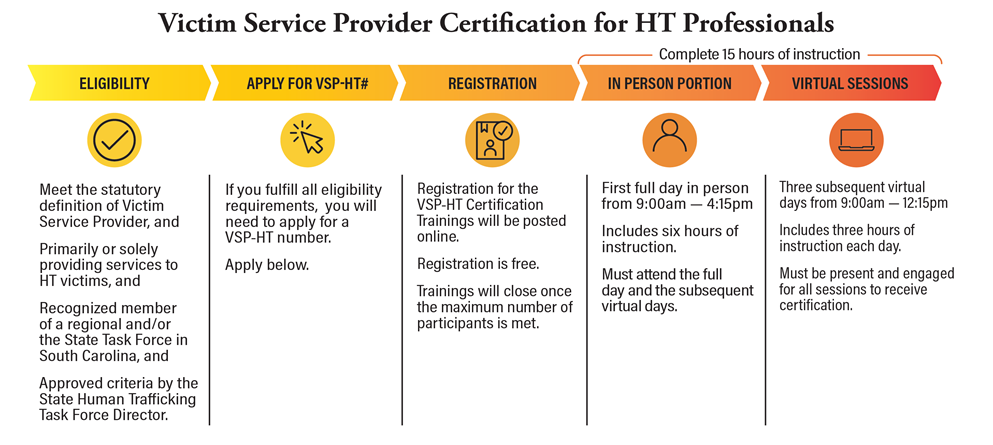VSP-HT certification
In January 2019, the South Carolina Human Trafficking Task Force partnered with the Attorney General’s Department of Crime Victim Services Training, Provider Certification, and Statistical Analysis to launch a specialized training for human trafficking service providers. The development of this training followed the passage of H3329.
This training is the first of its kind in South Carolina as well as the nation. Select providers who complete a minimum of 15 hours in approved VSP human trafficking specific basic core requirements will receive certification. Certification is maintained by a minimum of 12 hours of approved VSP continuing education each subsequent calendar year.
Requirements to be considered for VSP-HT certification
- A person who meets the statutory definition of Victim Service Provider (§ 16-3-1420), and
- Whose role is primarily or solely providing direct services to victims of human trafficking, and is
- A recognized member of a regional and/or the State Human Trafficking Task Force in South Carolina; and
- Is approved by the criteria established by the State Human Trafficking Task Force Coordinator.
SECTION 16-3-1420
- (1)"Victim service provider" means a person:
- (a) who is employed by a local government or state agency and whose job duties involve providing victim assistance as mandated by South Carolina law; or
- (b) whose job duties involve providing direct services to victims and who is employed by an organization that is incorporated in South Carolina, holds a certificate of authority in South Carolina, or is registered as a charitable organization in South Carolina, and the organization's mission is victim assistance or advocacy and the organization is privately funded or receives funds from federal, state, or local governments to provide services to victims.
- "Victim service provider" does not include a municipal court judge, magistrates court judge, circuit court judge, special circuit court judge, or family court judge.
- (2) "Witness" means a person who has been or is expected to be summoned to testify for the prosecution or who by reason of having relevant information is subject to call or likely to be called as a witness for the prosecution, whether or not an action or proceeding is commenced.






